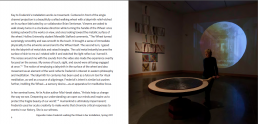Helen Frederick: Call and Response catalogue essay
Catalogue essay for “Helen Frederick: Dissonance.” 2012. Perfect bound book. Full color printing.
Helen Frederick is a visionary. Equally interested in object making and collaboration, she has pursued these twin efforts, which form the backbone of her work, with relentless drive, energy and curiosity. Comfortable with the categories: artist, educator, curator, entrepreneur and collaborator, Frederick is multi-faceted. She is part of community of artists who provoke viewer response vis-à-vis their endeavors into a call to action. Her work defies apathy. It demands our attention and involvement to complete it. She is stirred by our deadening of sensitivity to worldwide catastrophic events both natural and man-made. All material has an echo of memory. In “Dissonance,” Frederick’s work forges links in global information through interlinked media that invoke our collective consciousness. Exhibited works investigate the cacophony of our experiences in a sequence of site specific installations comprised of six stations entitled: “Endangered, Armored, Discolations, Preserved, Protection, and Movement.” She leads us through a meditative journey through the disparate yet interconnected stations and charging us to reflect. The artist states, “All of the objects placed in groups as comparative thought-provoking narratives and subalterns convey a journey that deals with psychological time, places of experience and suspension of time.“ 1
The centerpiece of “Dissonance” is an immense single channel video and sound projection by Frederick and collaborator Sean Watkins titled “Dislocated.” A morass of images barrage the viewer, some brutal others calming, culled from global historic events and Frederick’s own personal history that span from the 1950s to current times. Mined from super 8 footage, her Olympus Pen camera, television and other sources, viewers catch glimpses of an atomic bomb, a lunar moon with the artist’s hands superimposed, snippets of a riot from behind police lines, a broken glass shattering, all with the soft vocal overlay of the artist crooning over and over again the old English verb scieran meaning “to shear.” Born during the midst of the atomic bomb era, Frederick was raised during a particularly mercurial time. Citing her origins in terms of historical global crisis, it was a seminal moment for her artistic genesis. In totality, “Dislocated” speaks to Frederick’s innate interest in creating relationships between disparate images thus allowing the viewer to build their own metaphors. Frederick asks “We leave two tons of debris behind in our lifetime; what is absorbed and what is left behind?” 2
Key to Frederick’s installation works is movement. Centered in front of the single channel projection is a beautifully crafted walking wheel with a labyrinth relief-etched on its surface fabricated by co-collaborator Brian Sentsman. Viewers are asked to walk slowly twice in a clockwise direction while turning the handle of the Wheel: once looking outward to the works on view, and once looking toward the metallic surface of the wheel. Hollins University student Meredith Stafford comments, “The Wheel turned surprisingly smoothly and was smooth to the touch. It brought a sense of immediate physicality to the artworks around and to the Wheel itself. The second turn, I gazed into the labyrinth of metal dots and raised triangles. The cold metal instantly became the surface of skin to me as I rotated with it and watched the light reflect as I turned it. The noises around me with the sounds from the video also made the experience overtly focused on the senses. My sense of touch, sight, and sound were all being engaged at once.”3 The notion of employing a labyrinth in the surface of the wheel and also movement as an element of the work reflects Frederick’s interest in eastern philosophy and meditation. The labyrinth for centuries has been used as a fulcrum tool for ritual meditation, as well as a source of pilgrimage. Frederick’s intent is similar but pushes further, instilling the Wheel—a sensory device—as an apparatus for meditative focus. In her seminal tome, “Art in Action” author Mia Hanak states, “Artists help us change the way we see. Deepening our understanding can open our minds and inspire us to protect the fragile beauty of our world.” 4 Humankind is ultimately impermanent; Frederick uses her acute creativity to make works that chronicle critical responses to events in our history. She is our witness.
Invoking viewer reflection through protection, Frederick employs an introspective route through those related yet discordant stations and an interactive element to recapture links in our memory as individuals and as a larger entity. What inspires Frederick to take action through her work? “Dissonance” features her exploration of challenging events of our living generations and the human ability to process and filter that information. Furthermore, in “Dissonance,” the museum space itself acts as a walking wheel. One enters the space, moves clockwise through exquisite works titled and content driven on essential human needs: hunger, labor, water, protection and evolution, finally ending at the walking wheel. In totality, all the works in the exhibition function as tools of self-awareness reminding us of our place in the larger universe.
1 Helen Frederick’s keynote lecture at the Eleanor D. Wilson Museum. February 16, 2011
2 Artist’s exhibition statement, 2010.
3 Meredith Stafford, The Walking Wheel, Student exhibition review. April 2011.
4 Mia Hanak. Art in Action: Nature, Creativity and Our Collective Future. 2007.
(Natural World Museum, 2007), 170-71.
Amy G. Moorefield, Director and Chief Curator
Eleanor D. Wilson Museum at Hollins University


